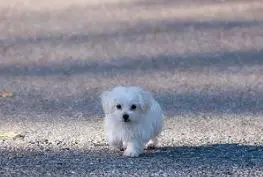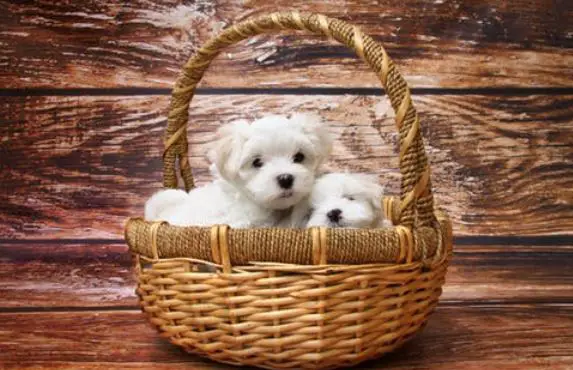What is a Teacup Maltese, Miniature Maltese and a Toy size Maltese?
Teacup, Miniature and Toy classes within a breed all refer to the smaller sizes of dog within the breed. Some breeders have tried to breed smaller dogs based on the demand shown from buyers for a smaller dog. This is because people perceive that a smaller dog is easier to manage and carry around. This ownership of smaller dogs has also become a trend as there has been many pictures of celebrities carrying their dogs around in their handbags. For a dog to fit in a handbag it needs to be on the smallest side of the dog breeds.
Toy Maltese, Miniature Maltese and Teacup Maltese Definitions
Maltese already fit into the class of breeds which is termed a toy breed. This is because the Maltese breed are one of the smallest breeds in existence. Within the Maltese breed though, there is what some breeders try and sell as an even smaller class called the Miniature Maltese which can also be known as the Teacup Maltese. These selling terms of “teacup Maltese”, “miniature Maltese” and the “toy size Maltese”, refer to the same type of dog, which in reality is just a Maltese which is likely to be a smaller size Maltese as an adult then the average size Maltese dog. They can not guarantee the dog will be smaller. Genetics influences the size of the dog and even though they have breed smaller Maltese together that does not guarantee that the Maltese puppy will not be bigger than its Maltese parents.
The Maltese dog being a small dog already only weighs in at around 7 lbs (or in metric 3.1 kg). Even those dogs within 4 lbs to 7 lbs ( which is 1.8 kgs to 3.1 kgs) of the Maltese breed are not much smaller than the average size of 7 lbs. What I am trying to say is that Maltese are small dogs regardless if they are termed toy, Miniature or teacup size.
It is impossible for a fully grown Maltese to be under 2 lbs. Its very improbable to find Maltese in the 2 lbs to 3 lbs range. While this light weight is possible and can occur naturally, it is normally due to health issues and is associated with the runt of the litter. If you are trying to find the smallest Maltese you can, then this may be setting yourself up for a lifetime of health related issues with your Maltese puppy. Some breeders will try and breed the smallest Maltese dogs they have in order to genetically create a smaller version of the Maltese so that it can be sold as a Teacup Maltese. This selective breeding may not be the best idea as it encourages the gene pool to focus on the runts of the litter who were usually the Maltese puppies which had the hardest time in the wild. If you have a small Maltese puppy though it does not mean they will have health issues, it is just more likely to occur. It is most likely that a Maltese adult dog will be at least 3 lbs ranging up to 7 lbs, Any Maltese dog between these weights is a typical size Maltese dog. This is because the standard size for a Maltese dog is any weight being under 7 lbs. So any Maltese puppy that has a weight above 3 lbs and is marketed to the consumer as a Teacup Maltese or Miniature Maltese should be viewed as a marketing tactic to get you to pay more. It should be known that they are simply a Maltese dog.

Why did the terms Teacup Maltese and Miniature Maltese come into use ?
The term Teacup Maltese is used to describe small Maltese dogs for three main reasons, these are broken down as follows:
- They are using the word “teacup” as a descriptive word. So when people are talking about a dog being “teacup” size they are simply meaning that the dog in question is really small. This can be a deceiving term as it can come across as dishonest or untrue as Maltese as a breed are considered “toy” sized and therefore are already recognized as one of the smallest dog breeds.
- To give a reason for a Maltese dog being smaller than normal. The term “teacup Maltese” is often used to describe a Maltese puppy who may be on the smaller side. But it should be known that being on the smaller side does not mean that this puppy is a teacup Maltese. It could be that the Maltese puppy is just going to be on the smaller end of the weight scale of the breed and may weigh in as an adult in the 3 lbs to 5 lbs range. It can also mean that the Maltese puppy is the runt of the litter and if this is the case you should be careful when purchasing. Runts of the litter often have health problems and can be an expensive investment in the long run as they may need a lot of medical assistance which can add up very quickly. Do not think that because the dog is smaller than the others it is cuter (although it probably is very cute) and therefore a wise choice, this is often untrue.
- It is used to be deceiving and make excess money. Some dog breeders will often advertise a dog as being “teacup” to entice potential buyers. This term is used because when buyers hear that a Maltese is teacup they tend to think that they are getting a “rarer” type of dog breed. The people buying the Maltese dog think of it as being a small and cute little dog and one that is highly desirable. This is a way of manipulating buyers to pay more money for a dog that is simply a Maltese, even if it is a bit smaller than an average Maltese. Prices for “teacup” Maltese can be hundreds of dollars more and can see a potential buyer waste a lot of money. A few years ago people avoided the runts of the litter due to the likelihood of health issues but now the breeders have found a way to not only sell the runts of the litter but to also make extra profit from them. Its a very good marketing trick which they are using. Reputable breeders will not advertise a Maltese being “Teacup” or “Miniature” as they know that this is not a real thing and that it is just used by those who wish to swindle and manipulate buyers. These reputable Maltese breeders will usually take the time to let buyers know about this issue and educate them on the real facts. They also often include a statement about “Teacup Maltese’s” in their advertisements or on their websites. Therefore you should be very wary of anyone advertising teacup Maltese dogs for sale as we know that this is only a marketing term used to sell more and make more money.
Benefits of Owning a Teacup Maltese and Miniature Maltese (or Small Maltese)
Now that we know that there is no such thing as a real teacup Maltese we can talk about the benefits of having a smaller Maltese dog. Provided the Maltese dog you have purchased is just small and is in fact healthy then there is much to gain from owning a small Maltese dog. Small dogs are very desirable in the current times as pets. There are many reasons for this including
- They are very easy to care for. Because of their smaller size they are very easy to bathe, brush and keep clean. A dog which is easier to care for is something that is sought after in the current times as busy people do not have the time for excessive grooming and often do not want to waste their money on outsourcing grooming and bathing for their Maltese dog.
- They do not eat a lot. Because of their small size Maltese do not eat a lot of food. This means that the money you will be spending weekly on your Maltese food bill will be substantially less than what you pay for a larger dog such as a golden retriever. These savings in food costs will add up very quickly into considerable savings.
- They are suitable for small places. A lot of people in apartments and units are attracted to getting a Maltese dog because of their small size. This is because they do not take up a lot of space in the apartment. This makes a small Maltese perfect for people with small homes or those who live in the inner city.
- They are great companion dogs. Because they are so small it is common for them to want to sit on your lap and spend time with you. For this reason, Maltese are sometimes referred to as lap dogs. They also like to snuggle up near you and also follow you around the house. They enjoy interacting with you and like being in your company as much as possible.

Common issues with Smaller Maltese such as “Teacup Maltese” and “Miniature Maltese”
From another perspective a smaller Maltese dog may not be the right choice for you. You should take the following into consideration:
- Do you have a lot of steps in your home? This is an important consideration because the Maltese are a small breed and they can find stairs in a home a challenge. You should take the layout of your home into consideration and determine if it will it be hard for the Maltese puppy to get around and be able to play and enjoy itself?
- Do you have small children who will be around the puppy? Small children can unintentionally hurt a small dog such as the Maltese. They can man handle them and often are prone to dropping them which can injure them and even break bones. It is very important that the Maltese puppy will be able to be safe and for this reason they are more suited to older children. Alternatively you should try and keep the children from carrying and picking up the Maltese puppy. It should be noted that dogs and small children should not be left alone together without supervision.
- Will you have the time required for owning a dog? With any dog you need to be able to dedicate enough time to being there with your dog. Small dogs like the Maltese breed are companion dogs and like to be around you. If you are not going to be home and will not have the time to spend with your Maltese puppy then it is better to not have one at this time in your life. Alternatively you could get another dog to keep them company. It is recommended to have another small dog with the Maltese as a bigger dog could unintentionally injure them.
So what did you think of our article on Teacup Maltese?
Did this article answer all of your questions on teacup Maltese? Did we miss anything which we should have added or is there another term which should be included? Do you have any thoughts on the term? Do you think it should be a term that is used for smaller Maltese? Let us known in the comments as its a very interesting topic and it is a bit controversial.

7 thoughts on “What is a Teacup Maltese, Miniature Maltese and a Toy size Maltese?”